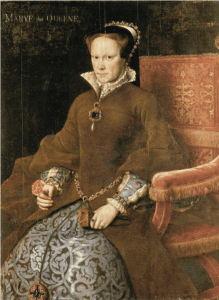
During her relatively short life, the daughter of Henry VIII and Catherine of Aragon had a rough time. After her mother’s marriage was annulled, she was not allowed to see her and was declared illegitimate. Her father would have nothing to do with her and once even threatened to execute her if she did not renounce her rights to the throne. Not surprisingly she was frequently ill, with bouts of fever, indigestion, and depression. When her father died in 1547, her younger brother, King Edward VI, renewed his persecutions because of her religion. But he died in 1553, and Mary executed a military coup and became queen.
A year later, in 1554, she married the Crown Prince of Spain, Philip, soon to become king, like all Habsburgs bent on growing their Empire through an acquisitive marriage. He came to England and was appalled by the bad weather and her lack of good looks. Within three months and again sometime later, the Queen was announced to be pregnant; but each time her periods returned, her abdomen flattened, and there was no baby.
In February 1558 Mary again believed herself to be pregnant. But by August she had fever and dropsy, in October was seriously ill, and died in November of that year. She was only forty-two years old. The cause of death has remained undetermined. It has been attributed to influenza, because there was an epidemic at that time, “strangulation of the womb,” ovarian cysts, uterine cancer, and even stomach cancer. Her amenorrhea has been attributed to phantom pregnancy or pseudocyesis. It has also been postulated that she had a pituitary tumor or prolactinoma, causing amenorrhea, swelling of the abdomen, morning sickness, breast swelling, and secretion of milk. She may also have had signs of associated hypothyroidism, loss of eyebrows, dry skin and confusion, as seen with large pituitary tumors. The precise cause of her death, however, remains unknown, unlike that of the 283 religious dissenters burned at the stake during her reign.
Reference
Medvei, VC. The illness and death of Mary Tudor. J R Soc Med. 1987;80(12):766-70.

Leave a Reply